Analyzing Research Methodologies in Education Research Papers
VerifiedAdded on 2023/06/16
|8
|2128
|494
Essay
AI Summary
This essay presents a critical review of two education research papers, one employing mixed methods to study school improvement and leadership, and the other using qualitative data to investigate inequality faced by teachers. The review analyzes the research topics, methodologies, and their appropriateness, discussing potential alternative methods. The mixed-methods paper effectively uses quantitative data to establish relationships between leadership and school improvement and qualitative data to gather opinions from staff. The qualitative study explores teachers' experiences with inequality through interviews, revealing factors contributing to racial prejudices. The review concludes by suggesting that mixed methods could offer a swift, systematic approach for exploring complex issues in both research areas. Desklib provides access to similar assignments.
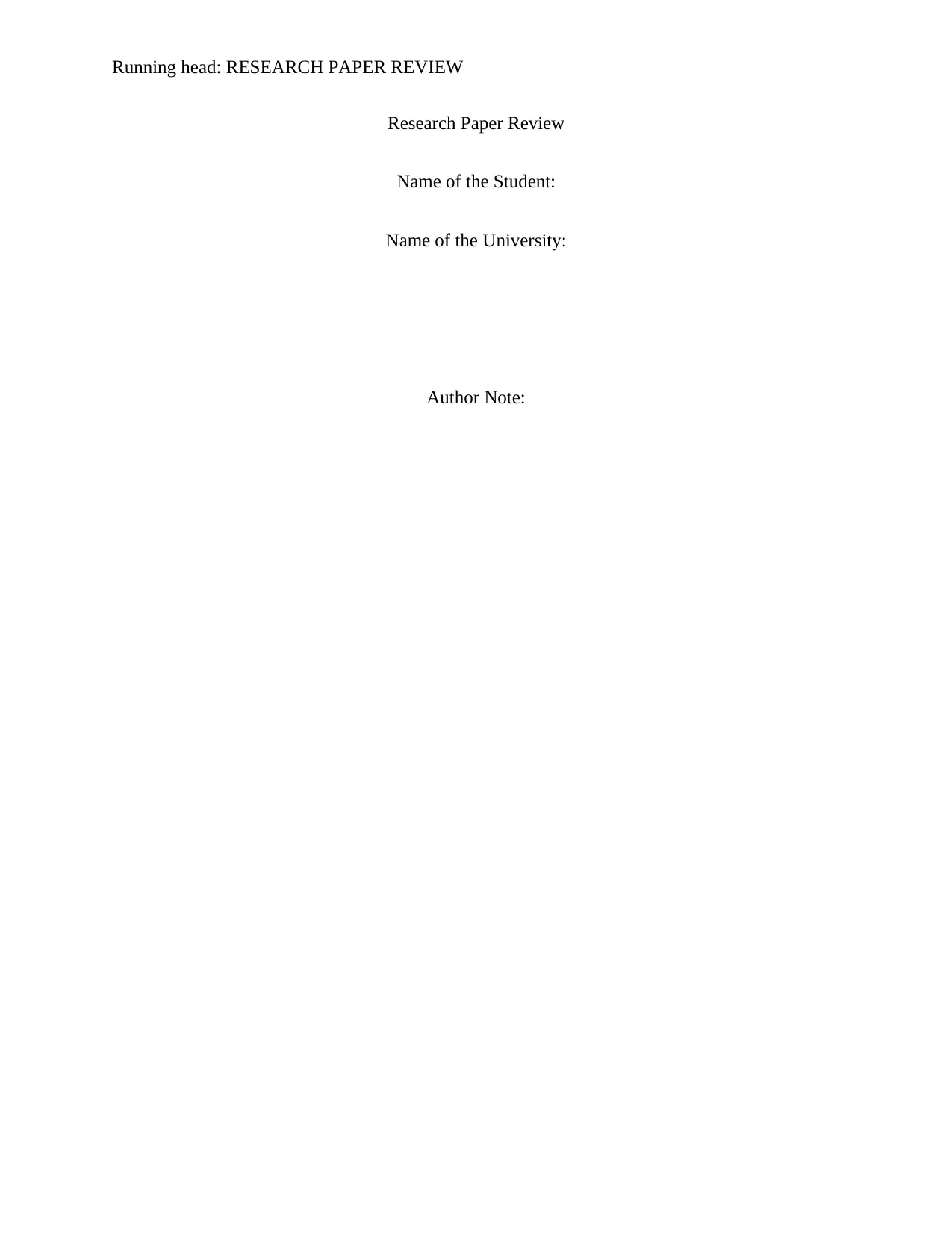
Running head: RESEARCH PAPER REVIEW
Research Paper Review
Name of the Student:
Name of the University:
Author Note:
Research Paper Review
Name of the Student:
Name of the University:
Author Note:
Paraphrase This Document
Need a fresh take? Get an instant paraphrase of this document with our AI Paraphraser
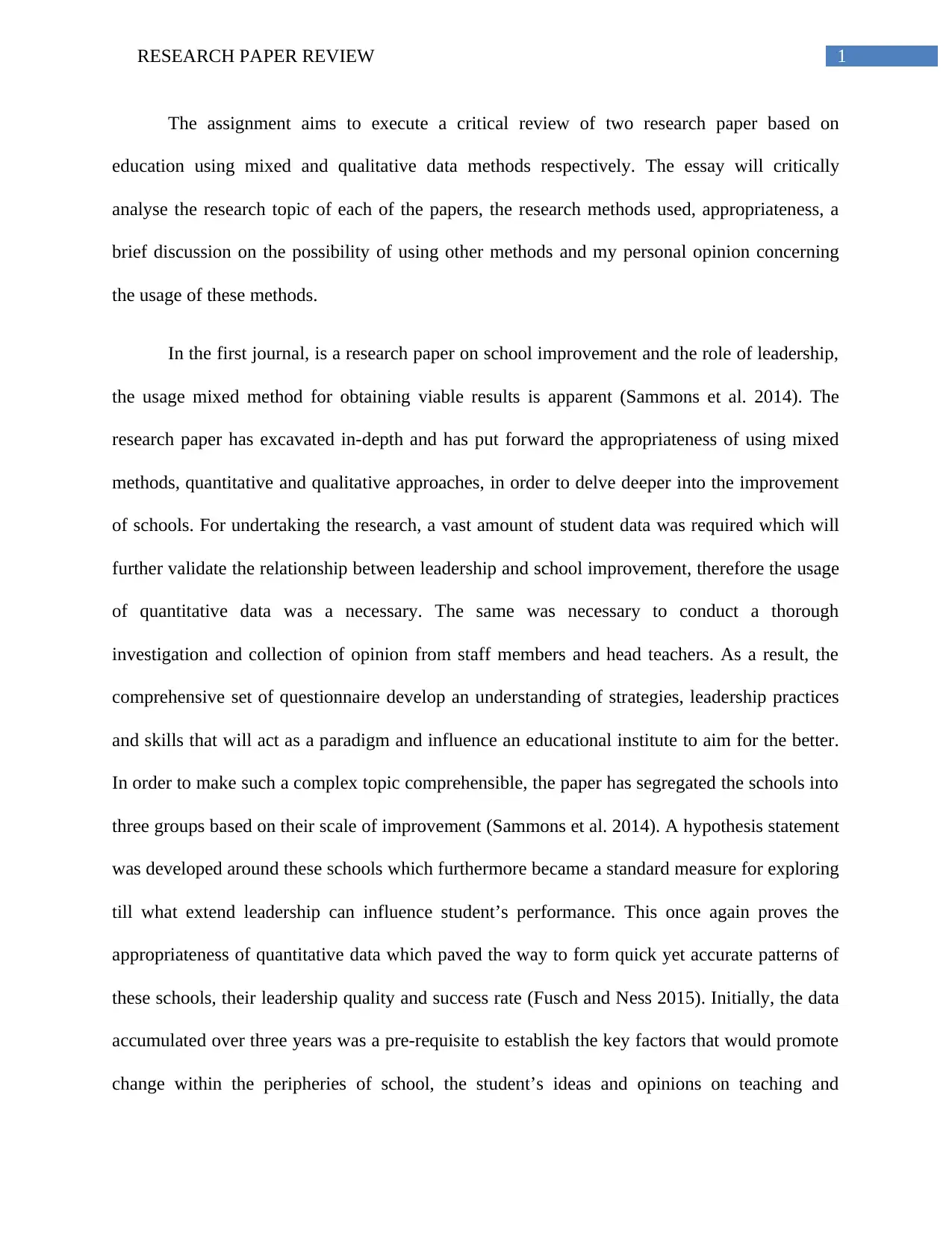
1RESEARCH PAPER REVIEW
The assignment aims to execute a critical review of two research paper based on
education using mixed and qualitative data methods respectively. The essay will critically
analyse the research topic of each of the papers, the research methods used, appropriateness, a
brief discussion on the possibility of using other methods and my personal opinion concerning
the usage of these methods.
In the first journal, is a research paper on school improvement and the role of leadership,
the usage mixed method for obtaining viable results is apparent (Sammons et al. 2014). The
research paper has excavated in-depth and has put forward the appropriateness of using mixed
methods, quantitative and qualitative approaches, in order to delve deeper into the improvement
of schools. For undertaking the research, a vast amount of student data was required which will
further validate the relationship between leadership and school improvement, therefore the usage
of quantitative data was a necessary. The same was necessary to conduct a thorough
investigation and collection of opinion from staff members and head teachers. As a result, the
comprehensive set of questionnaire develop an understanding of strategies, leadership practices
and skills that will act as a paradigm and influence an educational institute to aim for the better.
In order to make such a complex topic comprehensible, the paper has segregated the schools into
three groups based on their scale of improvement (Sammons et al. 2014). A hypothesis statement
was developed around these schools which furthermore became a standard measure for exploring
till what extend leadership can influence student’s performance. This once again proves the
appropriateness of quantitative data which paved the way to form quick yet accurate patterns of
these schools, their leadership quality and success rate (Fusch and Ness 2015). Initially, the data
accumulated over three years was a pre-requisite to establish the key factors that would promote
change within the peripheries of school, the student’s ideas and opinions on teaching and
The assignment aims to execute a critical review of two research paper based on
education using mixed and qualitative data methods respectively. The essay will critically
analyse the research topic of each of the papers, the research methods used, appropriateness, a
brief discussion on the possibility of using other methods and my personal opinion concerning
the usage of these methods.
In the first journal, is a research paper on school improvement and the role of leadership,
the usage mixed method for obtaining viable results is apparent (Sammons et al. 2014). The
research paper has excavated in-depth and has put forward the appropriateness of using mixed
methods, quantitative and qualitative approaches, in order to delve deeper into the improvement
of schools. For undertaking the research, a vast amount of student data was required which will
further validate the relationship between leadership and school improvement, therefore the usage
of quantitative data was a necessary. The same was necessary to conduct a thorough
investigation and collection of opinion from staff members and head teachers. As a result, the
comprehensive set of questionnaire develop an understanding of strategies, leadership practices
and skills that will act as a paradigm and influence an educational institute to aim for the better.
In order to make such a complex topic comprehensible, the paper has segregated the schools into
three groups based on their scale of improvement (Sammons et al. 2014). A hypothesis statement
was developed around these schools which furthermore became a standard measure for exploring
till what extend leadership can influence student’s performance. This once again proves the
appropriateness of quantitative data which paved the way to form quick yet accurate patterns of
these schools, their leadership quality and success rate (Fusch and Ness 2015). Initially, the data
accumulated over three years was a pre-requisite to establish the key factors that would promote
change within the peripheries of school, the student’s ideas and opinions on teaching and
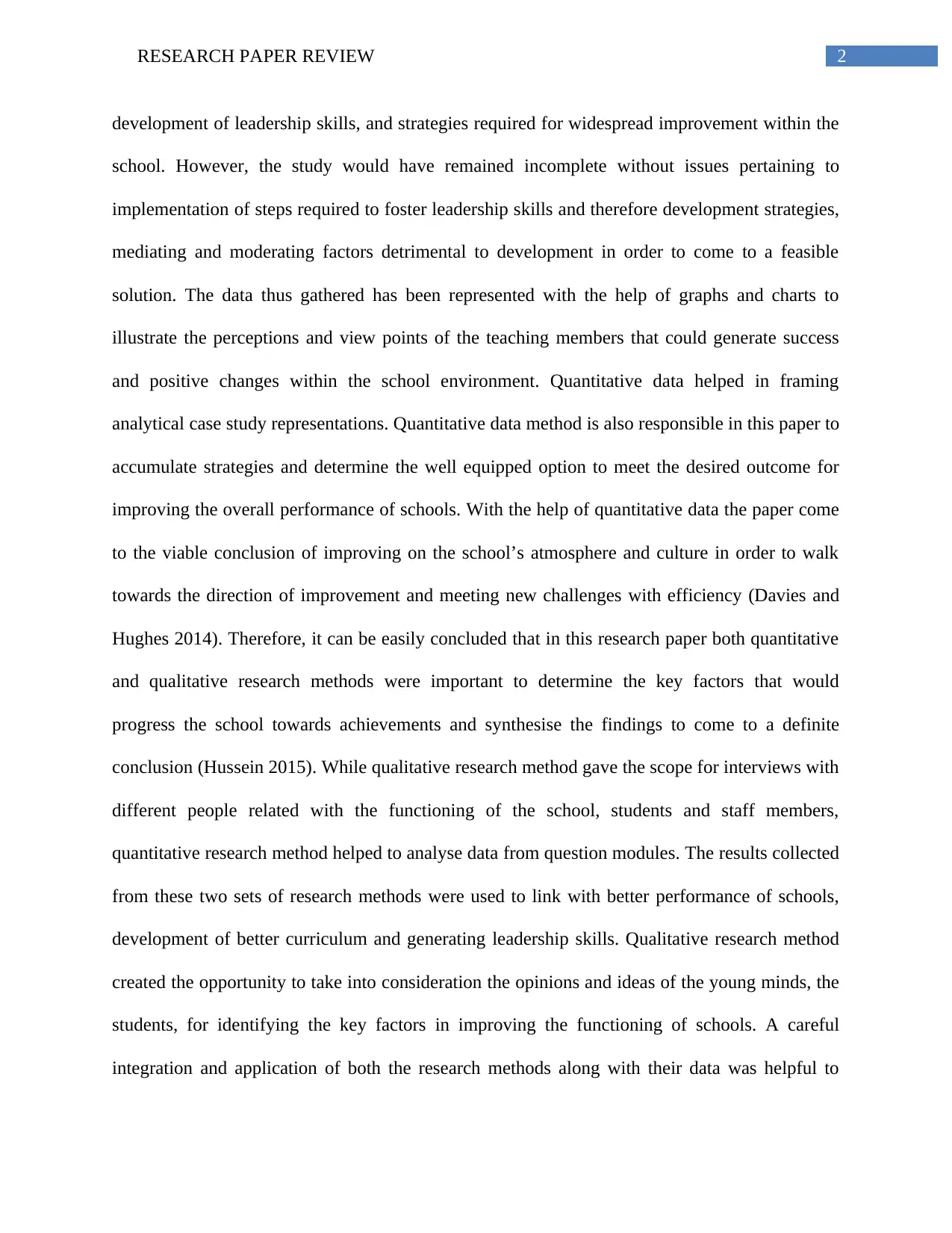
2RESEARCH PAPER REVIEW
development of leadership skills, and strategies required for widespread improvement within the
school. However, the study would have remained incomplete without issues pertaining to
implementation of steps required to foster leadership skills and therefore development strategies,
mediating and moderating factors detrimental to development in order to come to a feasible
solution. The data thus gathered has been represented with the help of graphs and charts to
illustrate the perceptions and view points of the teaching members that could generate success
and positive changes within the school environment. Quantitative data helped in framing
analytical case study representations. Quantitative data method is also responsible in this paper to
accumulate strategies and determine the well equipped option to meet the desired outcome for
improving the overall performance of schools. With the help of quantitative data the paper come
to the viable conclusion of improving on the school’s atmosphere and culture in order to walk
towards the direction of improvement and meeting new challenges with efficiency (Davies and
Hughes 2014). Therefore, it can be easily concluded that in this research paper both quantitative
and qualitative research methods were important to determine the key factors that would
progress the school towards achievements and synthesise the findings to come to a definite
conclusion (Hussein 2015). While qualitative research method gave the scope for interviews with
different people related with the functioning of the school, students and staff members,
quantitative research method helped to analyse data from question modules. The results collected
from these two sets of research methods were used to link with better performance of schools,
development of better curriculum and generating leadership skills. Qualitative research method
created the opportunity to take into consideration the opinions and ideas of the young minds, the
students, for identifying the key factors in improving the functioning of schools. A careful
integration and application of both the research methods along with their data was helpful to
development of leadership skills, and strategies required for widespread improvement within the
school. However, the study would have remained incomplete without issues pertaining to
implementation of steps required to foster leadership skills and therefore development strategies,
mediating and moderating factors detrimental to development in order to come to a feasible
solution. The data thus gathered has been represented with the help of graphs and charts to
illustrate the perceptions and view points of the teaching members that could generate success
and positive changes within the school environment. Quantitative data helped in framing
analytical case study representations. Quantitative data method is also responsible in this paper to
accumulate strategies and determine the well equipped option to meet the desired outcome for
improving the overall performance of schools. With the help of quantitative data the paper come
to the viable conclusion of improving on the school’s atmosphere and culture in order to walk
towards the direction of improvement and meeting new challenges with efficiency (Davies and
Hughes 2014). Therefore, it can be easily concluded that in this research paper both quantitative
and qualitative research methods were important to determine the key factors that would
progress the school towards achievements and synthesise the findings to come to a definite
conclusion (Hussein 2015). While qualitative research method gave the scope for interviews with
different people related with the functioning of the school, students and staff members,
quantitative research method helped to analyse data from question modules. The results collected
from these two sets of research methods were used to link with better performance of schools,
development of better curriculum and generating leadership skills. Qualitative research method
created the opportunity to take into consideration the opinions and ideas of the young minds, the
students, for identifying the key factors in improving the functioning of schools. A careful
integration and application of both the research methods along with their data was helpful to
⊘ This is a preview!⊘
Do you want full access?
Subscribe today to unlock all pages.

Trusted by 1+ million students worldwide
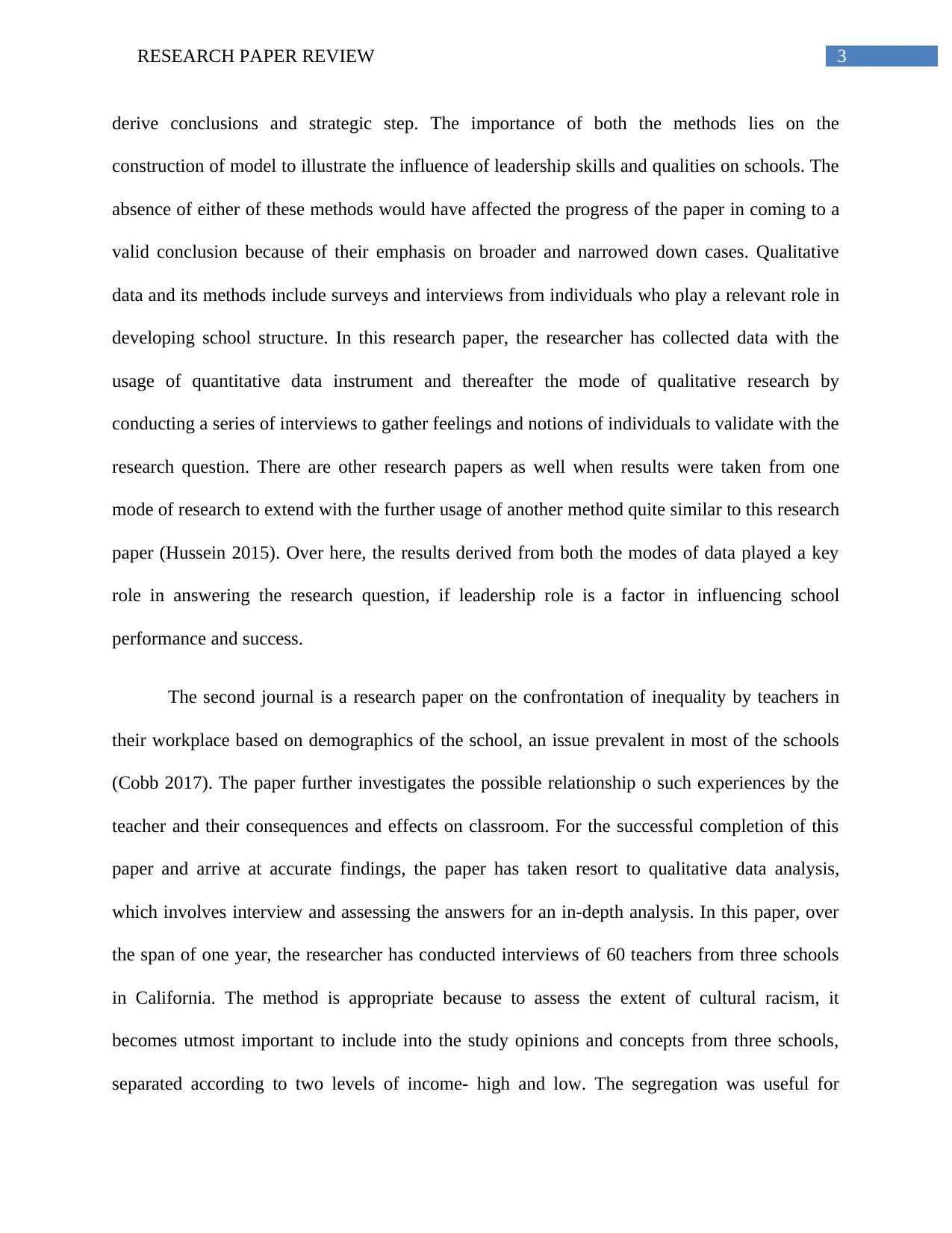
3RESEARCH PAPER REVIEW
derive conclusions and strategic step. The importance of both the methods lies on the
construction of model to illustrate the influence of leadership skills and qualities on schools. The
absence of either of these methods would have affected the progress of the paper in coming to a
valid conclusion because of their emphasis on broader and narrowed down cases. Qualitative
data and its methods include surveys and interviews from individuals who play a relevant role in
developing school structure. In this research paper, the researcher has collected data with the
usage of quantitative data instrument and thereafter the mode of qualitative research by
conducting a series of interviews to gather feelings and notions of individuals to validate with the
research question. There are other research papers as well when results were taken from one
mode of research to extend with the further usage of another method quite similar to this research
paper (Hussein 2015). Over here, the results derived from both the modes of data played a key
role in answering the research question, if leadership role is a factor in influencing school
performance and success.
The second journal is a research paper on the confrontation of inequality by teachers in
their workplace based on demographics of the school, an issue prevalent in most of the schools
(Cobb 2017). The paper further investigates the possible relationship o such experiences by the
teacher and their consequences and effects on classroom. For the successful completion of this
paper and arrive at accurate findings, the paper has taken resort to qualitative data analysis,
which involves interview and assessing the answers for an in-depth analysis. In this paper, over
the span of one year, the researcher has conducted interviews of 60 teachers from three schools
in California. The method is appropriate because to assess the extent of cultural racism, it
becomes utmost important to include into the study opinions and concepts from three schools,
separated according to two levels of income- high and low. The segregation was useful for
derive conclusions and strategic step. The importance of both the methods lies on the
construction of model to illustrate the influence of leadership skills and qualities on schools. The
absence of either of these methods would have affected the progress of the paper in coming to a
valid conclusion because of their emphasis on broader and narrowed down cases. Qualitative
data and its methods include surveys and interviews from individuals who play a relevant role in
developing school structure. In this research paper, the researcher has collected data with the
usage of quantitative data instrument and thereafter the mode of qualitative research by
conducting a series of interviews to gather feelings and notions of individuals to validate with the
research question. There are other research papers as well when results were taken from one
mode of research to extend with the further usage of another method quite similar to this research
paper (Hussein 2015). Over here, the results derived from both the modes of data played a key
role in answering the research question, if leadership role is a factor in influencing school
performance and success.
The second journal is a research paper on the confrontation of inequality by teachers in
their workplace based on demographics of the school, an issue prevalent in most of the schools
(Cobb 2017). The paper further investigates the possible relationship o such experiences by the
teacher and their consequences and effects on classroom. For the successful completion of this
paper and arrive at accurate findings, the paper has taken resort to qualitative data analysis,
which involves interview and assessing the answers for an in-depth analysis. In this paper, over
the span of one year, the researcher has conducted interviews of 60 teachers from three schools
in California. The method is appropriate because to assess the extent of cultural racism, it
becomes utmost important to include into the study opinions and concepts from three schools,
separated according to two levels of income- high and low. The segregation was useful for
Paraphrase This Document
Need a fresh take? Get an instant paraphrase of this document with our AI Paraphraser
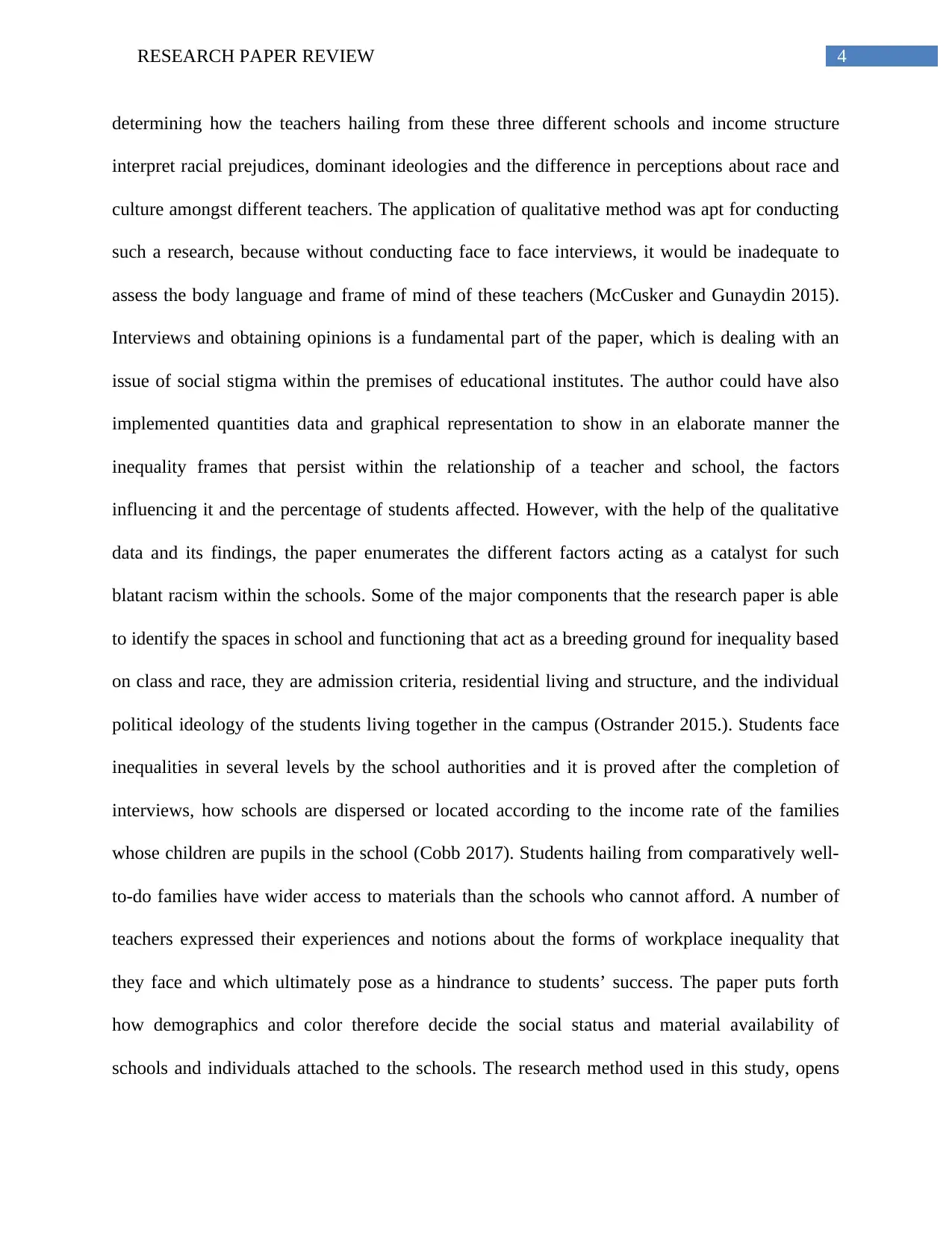
4RESEARCH PAPER REVIEW
determining how the teachers hailing from these three different schools and income structure
interpret racial prejudices, dominant ideologies and the difference in perceptions about race and
culture amongst different teachers. The application of qualitative method was apt for conducting
such a research, because without conducting face to face interviews, it would be inadequate to
assess the body language and frame of mind of these teachers (McCusker and Gunaydin 2015).
Interviews and obtaining opinions is a fundamental part of the paper, which is dealing with an
issue of social stigma within the premises of educational institutes. The author could have also
implemented quantities data and graphical representation to show in an elaborate manner the
inequality frames that persist within the relationship of a teacher and school, the factors
influencing it and the percentage of students affected. However, with the help of the qualitative
data and its findings, the paper enumerates the different factors acting as a catalyst for such
blatant racism within the schools. Some of the major components that the research paper is able
to identify the spaces in school and functioning that act as a breeding ground for inequality based
on class and race, they are admission criteria, residential living and structure, and the individual
political ideology of the students living together in the campus (Ostrander 2015.). Students face
inequalities in several levels by the school authorities and it is proved after the completion of
interviews, how schools are dispersed or located according to the income rate of the families
whose children are pupils in the school (Cobb 2017). Students hailing from comparatively well-
to-do families have wider access to materials than the schools who cannot afford. A number of
teachers expressed their experiences and notions about the forms of workplace inequality that
they face and which ultimately pose as a hindrance to students’ success. The paper puts forth
how demographics and color therefore decide the social status and material availability of
schools and individuals attached to the schools. The research method used in this study, opens
determining how the teachers hailing from these three different schools and income structure
interpret racial prejudices, dominant ideologies and the difference in perceptions about race and
culture amongst different teachers. The application of qualitative method was apt for conducting
such a research, because without conducting face to face interviews, it would be inadequate to
assess the body language and frame of mind of these teachers (McCusker and Gunaydin 2015).
Interviews and obtaining opinions is a fundamental part of the paper, which is dealing with an
issue of social stigma within the premises of educational institutes. The author could have also
implemented quantities data and graphical representation to show in an elaborate manner the
inequality frames that persist within the relationship of a teacher and school, the factors
influencing it and the percentage of students affected. However, with the help of the qualitative
data and its findings, the paper enumerates the different factors acting as a catalyst for such
blatant racism within the schools. Some of the major components that the research paper is able
to identify the spaces in school and functioning that act as a breeding ground for inequality based
on class and race, they are admission criteria, residential living and structure, and the individual
political ideology of the students living together in the campus (Ostrander 2015.). Students face
inequalities in several levels by the school authorities and it is proved after the completion of
interviews, how schools are dispersed or located according to the income rate of the families
whose children are pupils in the school (Cobb 2017). Students hailing from comparatively well-
to-do families have wider access to materials than the schools who cannot afford. A number of
teachers expressed their experiences and notions about the forms of workplace inequality that
they face and which ultimately pose as a hindrance to students’ success. The paper puts forth
how demographics and color therefore decide the social status and material availability of
schools and individuals attached to the schools. The research method used in this study, opens
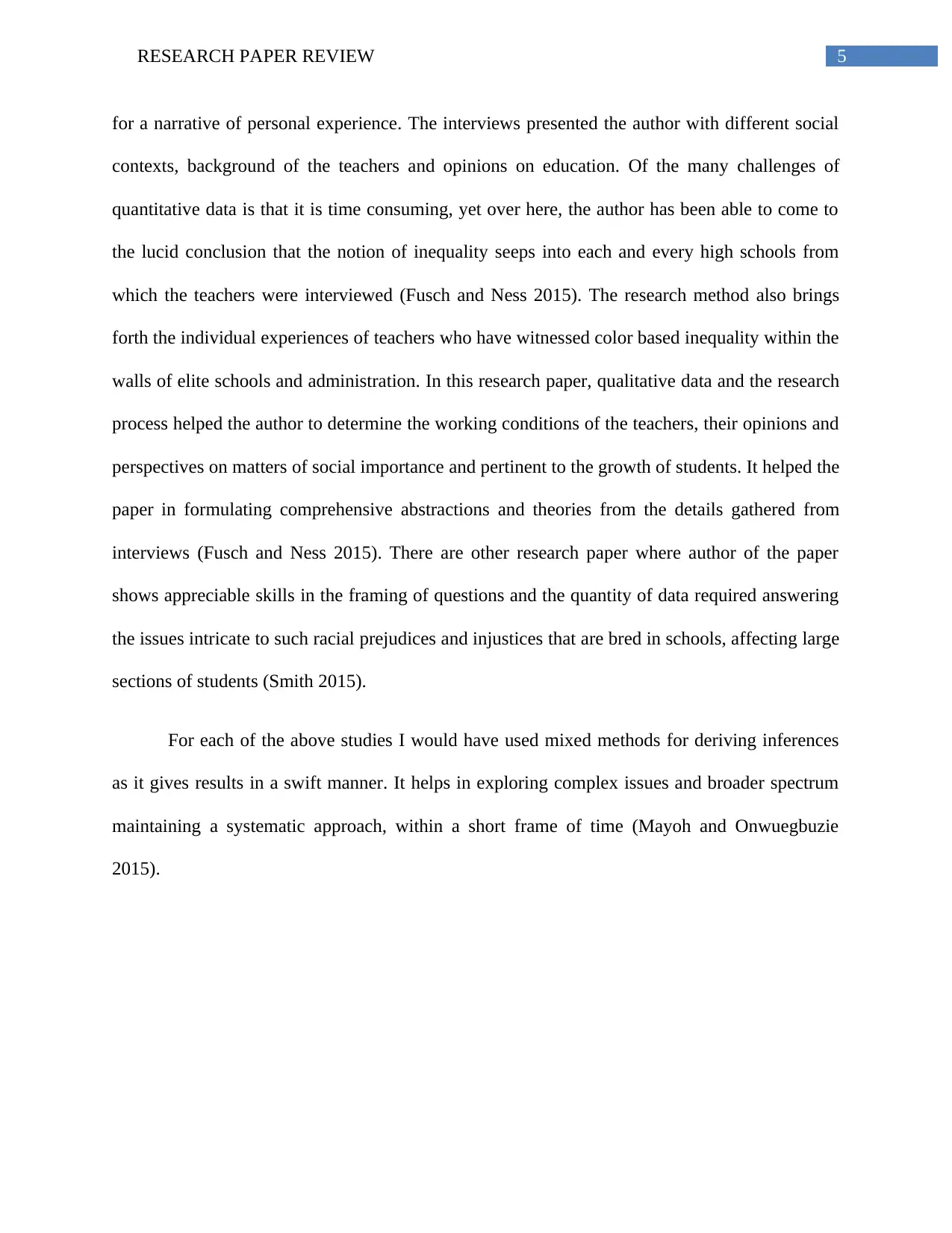
5RESEARCH PAPER REVIEW
for a narrative of personal experience. The interviews presented the author with different social
contexts, background of the teachers and opinions on education. Of the many challenges of
quantitative data is that it is time consuming, yet over here, the author has been able to come to
the lucid conclusion that the notion of inequality seeps into each and every high schools from
which the teachers were interviewed (Fusch and Ness 2015). The research method also brings
forth the individual experiences of teachers who have witnessed color based inequality within the
walls of elite schools and administration. In this research paper, qualitative data and the research
process helped the author to determine the working conditions of the teachers, their opinions and
perspectives on matters of social importance and pertinent to the growth of students. It helped the
paper in formulating comprehensive abstractions and theories from the details gathered from
interviews (Fusch and Ness 2015). There are other research paper where author of the paper
shows appreciable skills in the framing of questions and the quantity of data required answering
the issues intricate to such racial prejudices and injustices that are bred in schools, affecting large
sections of students (Smith 2015).
For each of the above studies I would have used mixed methods for deriving inferences
as it gives results in a swift manner. It helps in exploring complex issues and broader spectrum
maintaining a systematic approach, within a short frame of time (Mayoh and Onwuegbuzie
2015).
for a narrative of personal experience. The interviews presented the author with different social
contexts, background of the teachers and opinions on education. Of the many challenges of
quantitative data is that it is time consuming, yet over here, the author has been able to come to
the lucid conclusion that the notion of inequality seeps into each and every high schools from
which the teachers were interviewed (Fusch and Ness 2015). The research method also brings
forth the individual experiences of teachers who have witnessed color based inequality within the
walls of elite schools and administration. In this research paper, qualitative data and the research
process helped the author to determine the working conditions of the teachers, their opinions and
perspectives on matters of social importance and pertinent to the growth of students. It helped the
paper in formulating comprehensive abstractions and theories from the details gathered from
interviews (Fusch and Ness 2015). There are other research paper where author of the paper
shows appreciable skills in the framing of questions and the quantity of data required answering
the issues intricate to such racial prejudices and injustices that are bred in schools, affecting large
sections of students (Smith 2015).
For each of the above studies I would have used mixed methods for deriving inferences
as it gives results in a swift manner. It helps in exploring complex issues and broader spectrum
maintaining a systematic approach, within a short frame of time (Mayoh and Onwuegbuzie
2015).
⊘ This is a preview!⊘
Do you want full access?
Subscribe today to unlock all pages.

Trusted by 1+ million students worldwide
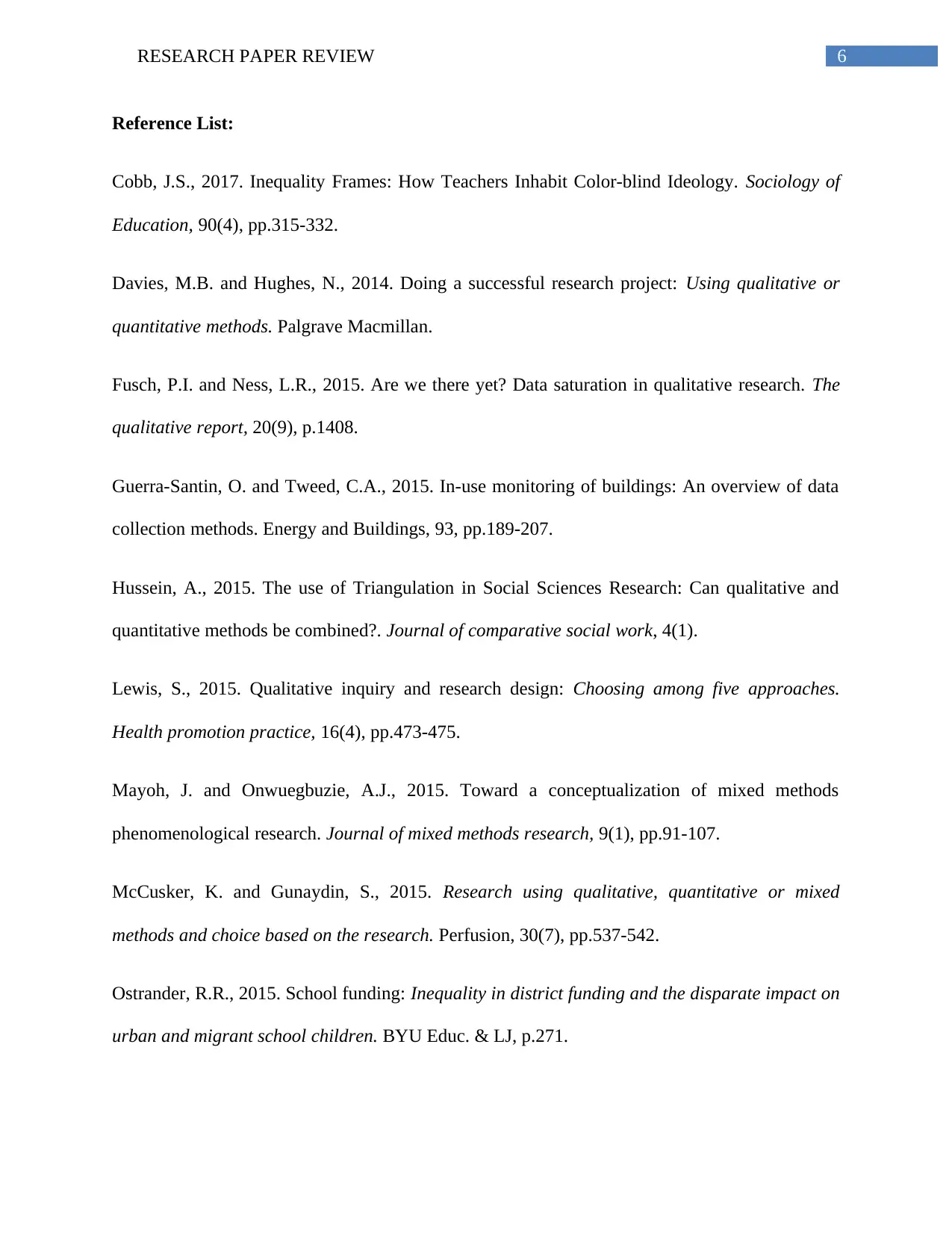
6RESEARCH PAPER REVIEW
Reference List:
Cobb, J.S., 2017. Inequality Frames: How Teachers Inhabit Color-blind Ideology. Sociology of
Education, 90(4), pp.315-332.
Davies, M.B. and Hughes, N., 2014. Doing a successful research project: Using qualitative or
quantitative methods. Palgrave Macmillan.
Fusch, P.I. and Ness, L.R., 2015. Are we there yet? Data saturation in qualitative research. The
qualitative report, 20(9), p.1408.
Guerra-Santin, O. and Tweed, C.A., 2015. In-use monitoring of buildings: An overview of data
collection methods. Energy and Buildings, 93, pp.189-207.
Hussein, A., 2015. The use of Triangulation in Social Sciences Research: Can qualitative and
quantitative methods be combined?. Journal of comparative social work, 4(1).
Lewis, S., 2015. Qualitative inquiry and research design: Choosing among five approaches.
Health promotion practice, 16(4), pp.473-475.
Mayoh, J. and Onwuegbuzie, A.J., 2015. Toward a conceptualization of mixed methods
phenomenological research. Journal of mixed methods research, 9(1), pp.91-107.
McCusker, K. and Gunaydin, S., 2015. Research using qualitative, quantitative or mixed
methods and choice based on the research. Perfusion, 30(7), pp.537-542.
Ostrander, R.R., 2015. School funding: Inequality in district funding and the disparate impact on
urban and migrant school children. BYU Educ. & LJ, p.271.
Reference List:
Cobb, J.S., 2017. Inequality Frames: How Teachers Inhabit Color-blind Ideology. Sociology of
Education, 90(4), pp.315-332.
Davies, M.B. and Hughes, N., 2014. Doing a successful research project: Using qualitative or
quantitative methods. Palgrave Macmillan.
Fusch, P.I. and Ness, L.R., 2015. Are we there yet? Data saturation in qualitative research. The
qualitative report, 20(9), p.1408.
Guerra-Santin, O. and Tweed, C.A., 2015. In-use monitoring of buildings: An overview of data
collection methods. Energy and Buildings, 93, pp.189-207.
Hussein, A., 2015. The use of Triangulation in Social Sciences Research: Can qualitative and
quantitative methods be combined?. Journal of comparative social work, 4(1).
Lewis, S., 2015. Qualitative inquiry and research design: Choosing among five approaches.
Health promotion practice, 16(4), pp.473-475.
Mayoh, J. and Onwuegbuzie, A.J., 2015. Toward a conceptualization of mixed methods
phenomenological research. Journal of mixed methods research, 9(1), pp.91-107.
McCusker, K. and Gunaydin, S., 2015. Research using qualitative, quantitative or mixed
methods and choice based on the research. Perfusion, 30(7), pp.537-542.
Ostrander, R.R., 2015. School funding: Inequality in district funding and the disparate impact on
urban and migrant school children. BYU Educ. & LJ, p.271.
Paraphrase This Document
Need a fresh take? Get an instant paraphrase of this document with our AI Paraphraser
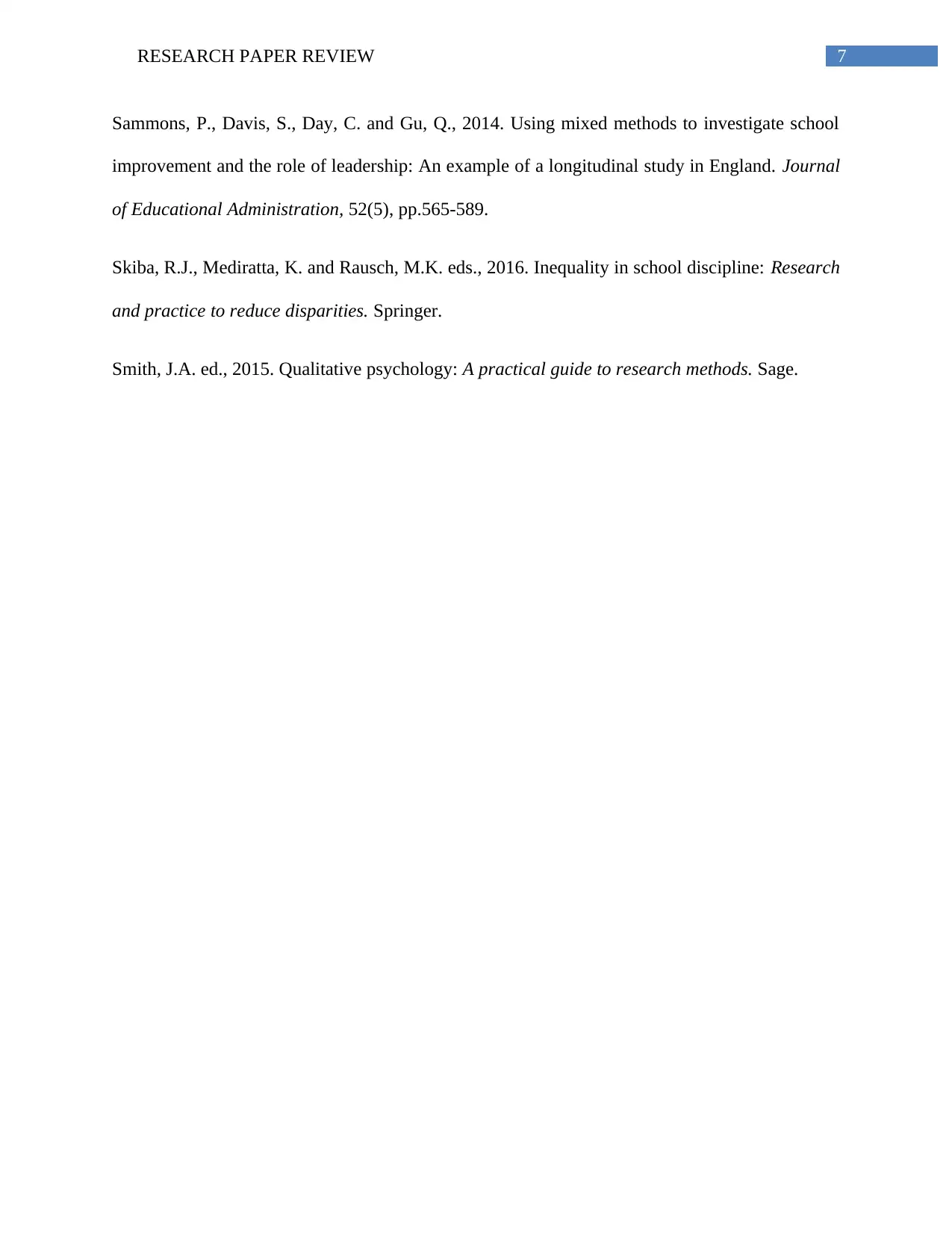
7RESEARCH PAPER REVIEW
Sammons, P., Davis, S., Day, C. and Gu, Q., 2014. Using mixed methods to investigate school
improvement and the role of leadership: An example of a longitudinal study in England. Journal
of Educational Administration, 52(5), pp.565-589.
Skiba, R.J., Mediratta, K. and Rausch, M.K. eds., 2016. Inequality in school discipline: Research
and practice to reduce disparities. Springer.
Smith, J.A. ed., 2015. Qualitative psychology: A practical guide to research methods. Sage.
Sammons, P., Davis, S., Day, C. and Gu, Q., 2014. Using mixed methods to investigate school
improvement and the role of leadership: An example of a longitudinal study in England. Journal
of Educational Administration, 52(5), pp.565-589.
Skiba, R.J., Mediratta, K. and Rausch, M.K. eds., 2016. Inequality in school discipline: Research
and practice to reduce disparities. Springer.
Smith, J.A. ed., 2015. Qualitative psychology: A practical guide to research methods. Sage.
1 out of 8
Related Documents
Your All-in-One AI-Powered Toolkit for Academic Success.
+13062052269
info@desklib.com
Available 24*7 on WhatsApp / Email
![[object Object]](/_next/static/media/star-bottom.7253800d.svg)
Unlock your academic potential
Copyright © 2020–2025 A2Z Services. All Rights Reserved. Developed and managed by ZUCOL.



